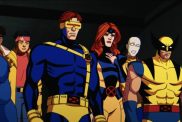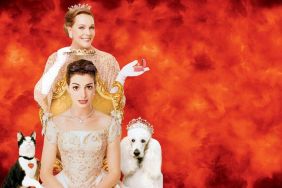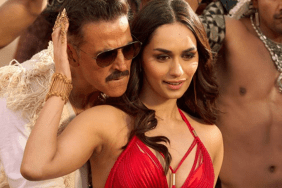
Believe it or not this was my first time ever seeing 2001. I know that may be hard to believe, but for regular readers of mine I don’t think it will be that hard to swallow. Of course the film was no mystery to me, I had heard plenty about just about every aspect of it. I felt like I knew HAL intimately, I knew the music and I knew the images. What I didn’t know was that this is not a film to watch only once. 2001 is a film to study, and I think Kubrick intended it that way even though the plotline isn’t that convoluted. You aren’t going to be rewatching 2001 to figure out the story, instead you are going to be watching to pick up on the subtle nuances of Kubrick’s direction and story-telling. You could even rewatch it and ask yourself, “How did they do that?”

The effects in this film are amazing, and that is before you ever consider it was made in 1968. The screen capture above is the one scene that I just couldn’t figure out, only because I guess I didn’t think it could be done the way they actually did it. You see, they are walking down a corridor that is stationary and the camera is attached to it. In the background is a second corridor that is spinning, but the instant they step into the other corridor the foreground corridor begins spinning and the background one stops, giving off a spectacular illusion. As with most movie tricks they are simple once you know how they are done, but this one truly impressed me.

If you want to talk visuals, how about the picture above of this cheetah resting over its prey? On DVD the scene looks stellar, and that is a screen capture from the DVD, but on HD DVD it looks even better, as do several of the nature shots and outer space shots throughout the film. This is the beauty of Kubrick’s film. This movie is more than just a story that will have you chatting with your friends long after it is over. 2001 is a lesson in visuals, sound and overall filmmaking techniques. This is a movie that doesn’t have a word of dialogue for the first 25 minutes and 40 seconds, but it does so much in its use of visuals and music that it doesn’t even matter. I won’t say that you won’t notice it, because you will, but it really doesn’t matter.

Taking everything into consideration, 2001 is not for everyone. This is not your typical sci-fi film. There is no Luke Skywalker and no battle droids, but there is one of the scariest pieces of artificial intelligence ever in a film. See that picture above? That is HAL, a name you will learn from the special features was actually created by just taking IBM and adjusting each letter by one.
HAL can think for himself and you even get the impression that he feels. He certainly can pick up on human emotions and where the frightening element comes in is when he displays a value for what he determines his own life. “Open the pod bay doors, HAL,” has become a quote everyone knows and when you hear it in context with the film it truly is frightening when accompanied with the calm voice Douglas Rain gave the artificial being.

However, while HAL may be the most memorable and most quoted character from the film his story is miniscule in the grand scheme of things even though it plays into the overall circle of life theme of the film. For anyone that hasn’t seen the film it is a slow, methodical and I would even say mythical tale that begins at the “Dawn of Man”. We are first introduced to a pack of apes (now you see why there is no dialogue). These apes are going about their everyday life until one day a large monolith appears (pictured above) in the ground. The monolith ultimately teaches the apes, educating them on how to evolve, and that is when at nearly 20 minutes into the film you get what is referred to on the back of the DVD packaging “one of the most mind-blowing jump cuts ever”. I will admit it is pretty cool to go from the primitive “Dawn of Man” to 2001 via the tossing of a bone, but I still want to know how they got King Kong from Skull Island to New York, that jump cut is still the best in my opinion.
Nevertheless, this monolith begins to play a role throughout the film, guiding human actions once another one is found buried on the surface of the moon and ultimately determining the outcome of one space cadet’s life.

The special features on 2001 are just the start of the goodies in this collection. For most Kubrick fans out there a lot of it may be old hat, but this collection is filled with documentaries on the making of the film and on Kubrick himself. Considering I am not a Kubrick scholar it was immensely interesting, and while I did have a few problems with the features on a couple of the discs this one works well.
I don’t follow suit with most, believing that 2001 is Kubrick’s greatest film, it is certainly a good one. However, above all that, this is a monstrous achievement, people could spend entire semesters in college discussing what Kubrick did with this film, and the best part of it is that the majority of the time would not be spent dissecting the story and its meaning, but more on Kubrick’s effective filmmaking techniques that were light years ahead of others. As you watch this film you will be astonished to learn that it came out 9 years before Star Wars. While Star Wars is loved for its effects, I would dare say 2001 eclipses it.
- A Clockwork Orange
- The Shining (Coming Soon)
- Full Metal Jacket (Coming Soon)
- Eyes Wide Shut (Coming Soon)










